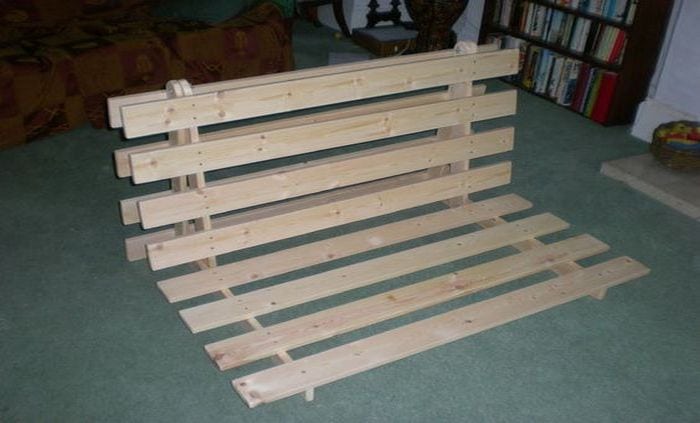
Don’t you just love lazing around on a comfortable sofa? More so after a tiring day at work. With a good book in hand, I have fallen asleep on my sofa many, many times. My husband used to joke that I should just turn it into a bed. So I thought, why not?
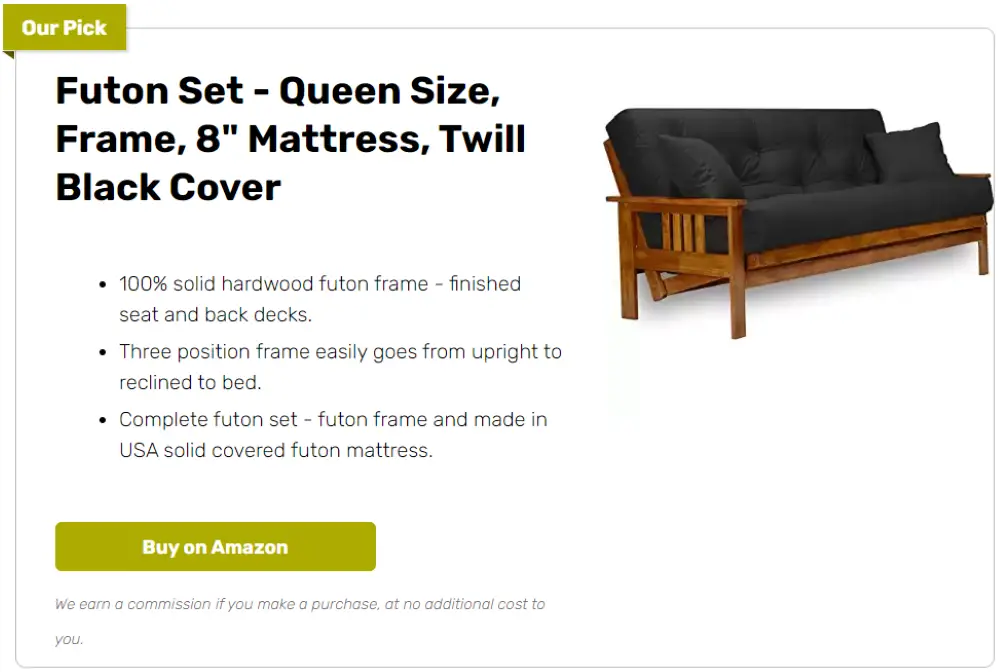
Contents
- 1 DIY Fold Out Futon Bed Frame: A Space-Saving Solution
- 2 Conclusion
DIY Fold Out Futon Bed Frame: A Space-Saving Solution
If you have a nook or an empty space that’s screaming for something, this project is perfect.
Building a Fold Out Futon Bed Frame
This fold out futon bed frame is actually a good idea. It’s tri-fold so it doesn’t take up too much space when not in use. And if you’re anything like me, I love a good project that allows me to save money. For this one, the savings was a little over $100.
Materials:
- 12 pcs 1200mm x 95mm wooden planks (20mm thickness)
- 2 pcs 770mm x 70 mm wooden planks (20mm thickness)
- 2 pcs 700mm x 70 mm wooden planks (20mm thickness)
- 2 pcs 690mm x 70 mm wooden planks (20mm thickness)
- stain, oil, or wax
- 46 pcs 40mm screws (4mm head)
- 4 pcs 6mm bolts (6mm is the diameter: length needs to be no less than 45mm, 50mm is ideal)
- 4 pcs 6mm wingnuts (or regular nuts))
Tools:
- Pencil
- Ruler (graduated in millimeters)
- Set Square (or similar)
- Protractor
- Electric Screwdriver/Drill
- 2.5mm drill bit
- 6.5mm drill bit
- Manual Screwdriver
- Saw
- Medium Grade Sandpaper
- Rasp or planer
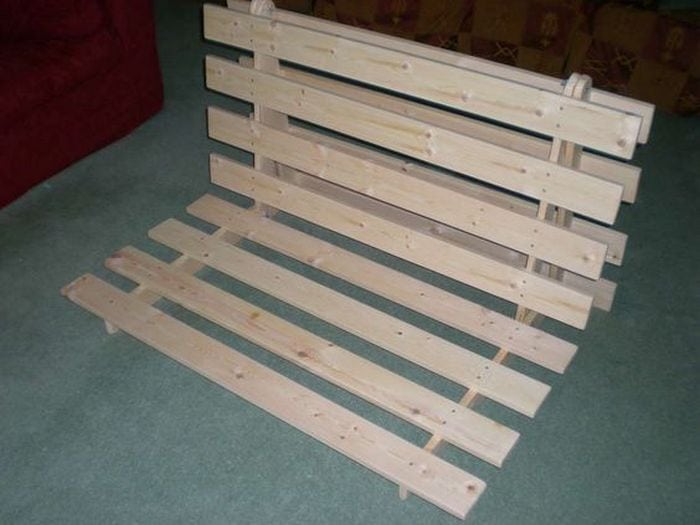
Instructions:
Step 1: Plan and Mark
- Lay out the 12 pieces of 1200mm x 95mm planks.
- Using a pencil, ruler, and set square, mark the areas where you will drill holes for screws. Ensure symmetry and accuracy in your markings.
Step 2: Cut and Shape
- If necessary, use the saw to cut any planks to their required sizes.
- Use the rasp or planer to smooth the edges of the cut wood.
Step 3: Drill Holes
- Using the 2.5mm drill bit, pre-drill holes in the marked spots on the wooden planks. This prevents wood splitting when inserting screws.
- For the sections that will pivot, use the 6.5mm drill bit to make larger holes for the bolts.
Step 4: Assemble the Frame
- Start assembling the frame by connecting the planks with the 40mm screws using the electric screwdriver.
- For movable joints (for the fold-out mechanism), insert the 6mm bolts and secure them with wingnuts or regular nuts. Ensure these joints are tight enough to hold but also allow for easy movement.
Step 5: Sanding
- Once the frame is assembled, sand the entire structure with medium-grade sandpaper. This step is important for a smooth finish, especially if you plan to stain or paint the frame.
Step 6: Finishing Touches
- Apply your chosen finish (stain, oil, or wax) to the wooden frame. Follow the product instructions for the best results.
- Allow the finish to dry completely before using the fold out futon bed frame.
Step 7: Final Inspection
- After the finish has dried, inspect the frame. Check all screws and bolts are tight, and the fold-out mechanism works smoothly.
Safety Tips for Building Your Fold Out Futon Bed Frame
Building your own fold out futon bed frame can be a rewarding DIY project. It’s essential to prioritize safety to ensure a successful and injury-free build. Here are some crucial safety tips to follow.
Wear Protective Gear
When assembling a fold-out futon bed frame, prioritize safety gear like goggles, gloves, and sturdy footwear with anti-slip soles to prevent injuries from wood chips, splinters, and falling tools. Personal protection is essential during construction.
Work in a Well-Lit, Ventilated Area
Selecting a bright workspace is crucial for accurate DIY projects to avoid errors and accidents, particularly for detailed tasks like joints and finishes. Ventilation is important for safety when using chemicals, ensuring good airflow for health and efficient finish drying for a high-quality fold-out futon bed frame.
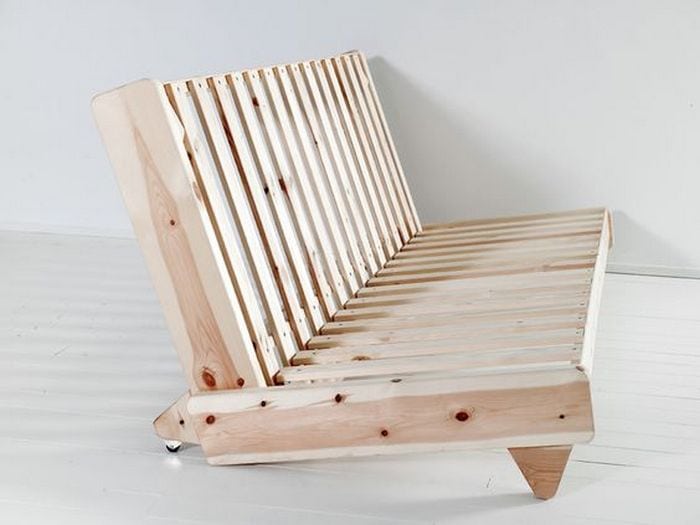
Use Tools Properly
Proper tool usage is essential for building a fold out futon bed frame. Get familiar with each tool, especially if they’re new. Read manuals for power tools like drills and saws to understand how to use them safely. Practice using tools before starting the project to build confidence. Use tools correctly for best results and safety.
Keep Workspace Organized
An organized workspace is essential for safety and efficiency when building a fold out futon bed frame. Designate task areas and keep tools accessible. Clear away debris to prevent accidents and fires. A clutter-free environment enhances focus and craftsmanship.
Regularly Check Materials
Inspect materials thoroughly for cracks, warps, or weaknesses before and during building your fold out futon bed frame. Flaws can compromise stability and safety. Replace damaged materials promptly for a strong and safe frame.
Secure Loose Clothing and Hair
It’s important to secure hair and clothing when using power tools to prevent injuries. Tie back long hair and wear fitted clothes to avoid accidents while working on projects like building a fold-out futon bed frame. Remember, safety in your workspace includes managing personal and environmental risks.
When considering a new futon frame design, there are several qualities that are highly desirable:
- Durability and Sturdiness
- Many individuals have experienced the disappointment of flimsy futon frames that wear out quickly. A robust and well-constructed frame is essential for long-term use and reliability.
- Simple and Timeless Design
- A mission-style frame, known for its clean lines and classic appeal, would be an excellent choice. This style complements a wide range of interior decorations and maintains its charm over time.
- Versatility
- Futons are often used in multi-purpose spaces, such as craft rooms or guest rooms. A frame should easily accommodate these transitions, offering both comfort as a sofa and support as a bed.
- Ease of Assembly
- A straightforward assembly process is crucial, especially for those who may not be experienced in furniture construction. Clear instructions and minimal tools should be involved.
- Affordability
- While durability is key, the frame should also be reasonably priced, appealing to those moving into new homes or apartments without breaking the bank.
- Environmentally Friendly
- Sustainably sourced materials and eco-friendly finishes would be appreciated by environmentally conscious consumers.
By incorporating these features, a futon frame can become a reliable and attractive addition to any home.
Click on any image to start the lightbox display. Use your Esc key to close the lightbox.





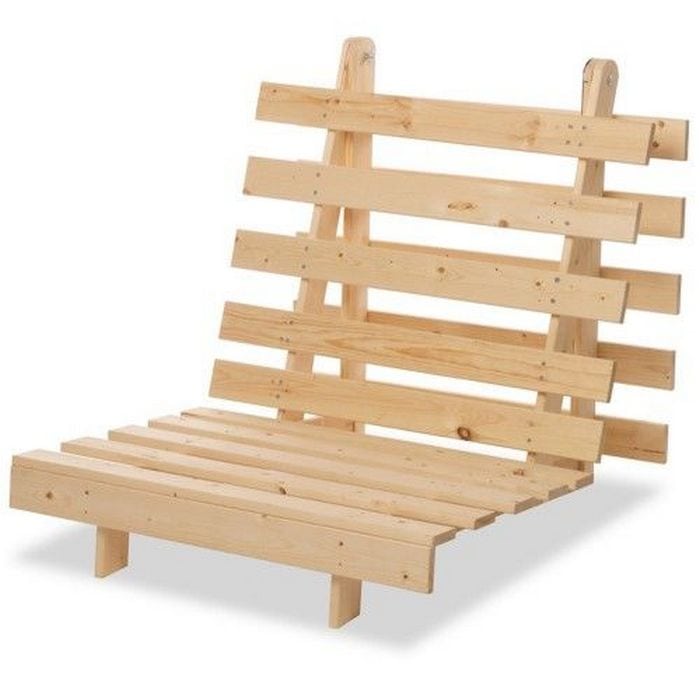
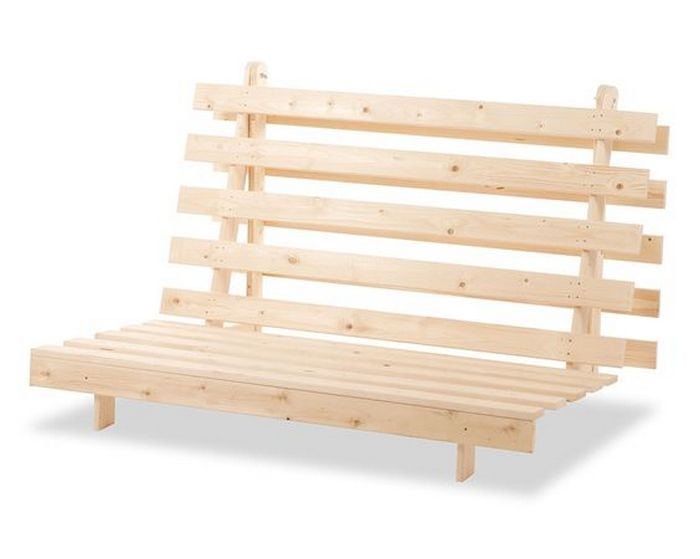
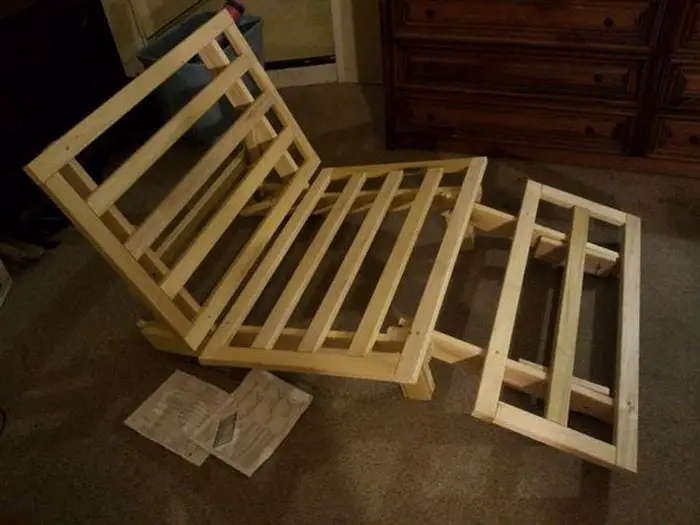
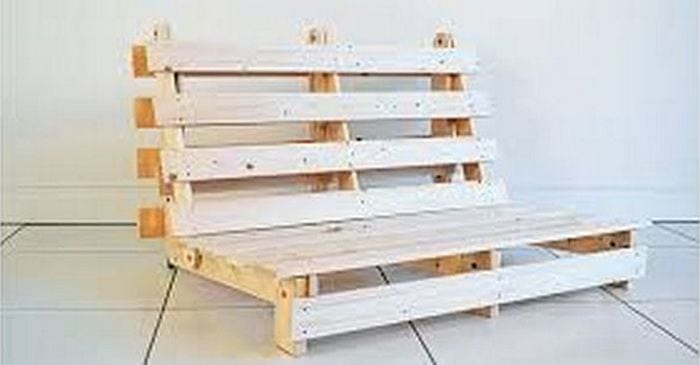
Styling Your Fold Out Futon Bed Frame
Once you’ve built your fold out futon bed frame, the next exciting step is styling it. A well-styled fold out futon bed frame can be the focal point of your room. Here are some tips to help you achieve a look that is both functional and aesthetically pleasing.
Choose a Color Scheme
Select a color scheme that complements your room. Neutral tones like beige, gray, or white offer versatility and can easily blend with various decor styles. If you prefer a bolder look for it, choose vibrant or dark colors that make a statement. Remember, the color you choose sets the tone for the entire room.
Select Comfortable and Attractive Bedding
The right bedding can transform the look of your fold out futon bed frame. Opt for comfortable materials like cotton or linen for a cozy feel. Patterns and colors in the bedding can add personality to the room. Consider seasonal changes, using lighter fabrics and colors in summer and warmer, richer tones in winter.
Add Pillows and Throws
Pillows and throws are not just for comfort; they are great for adding texture and layers to it. Mix and match different sizes, shapes, and textures of pillows. Throws can be draped over the back or side of the sofa for a relaxed, inviting look.
Incorporate Functional Accessories
Consider functional accessories like side tables or a magazine rack. These can enhance its utility, making it a perfect spot for relaxation or reading. Choose accessories that complement the overall style and color scheme of the room.
Styling your fold out futon bed frame is an opportunity to express your personal taste and create a comfortable, inviting space. With these tips, you can ensure your DIY project serves its purpose and enhances your home’s beauty.
Cost Comparison: DIY vs. Store-Bought
When considering a fold out futon bed frame, deciding between a DIY project and purchasing a store-bought piece is a common dilemma. Let’s explore the cost implications of both options to help you make an informed decision.
Initial Investment
- DIY: Building your own fold out futon bed frame requires buying materials and tools. While the cost of materials like wood, screws, and finishes may be lower than buying a finished product, you need to factor in the cost of tools if you don’t already own them.
- Store-Bought: A ready-made fold out futon bed frame comes at a fixed price. This price generally includes design, labor, and material costs. Higher-end models can be quite expensive, but you can also find budget-friendly options.
Customization and Quality
- DIY: The major advantage of a DIY fold out futon bed frame is the ability to customize. You can choose materials and designs that match your specific needs and taste. While this might increase costs, it also means potentially higher quality and personalization.
- Store-Bought: With store-bought items, what you see is what you get. Customization is limited, and you might have to compromise on materials and design. However, you benefit from professional craftsmanship, which can be a plus for durability and aesthetics.
Time Investment and Skill Level
- DIY: Your time is valuable. Building it requires a significant time commitment, especially if you’re new to woodworking. The learning curve can be steep, but it’s a rewarding experience if you have the time and interest.
- Store-Bought: Purchasing it is straightforward and time-efficient. It’s ideal if you need something quickly and lack the time or skills for a DIY project.
Long-Term Value
- DIY: A well-made DIY fold out sofa/futon/bed frame can last many years. The skills you learn can be applied to future projects, adding value beyond the immediate product.
- Store-Bought: The longevity of a store-bought frame depends on its quality. High-quality models can be durable but may come at a higher price.
The choice between DIY and store-bought depends on your budget, time, skills, and the value you place on customization. DIY projects can be more cost-effective and rewarding but require significant time and effort investment. Store-bought options offer convenience and professional craftsmanship at a fixed cost.

Maintenance Tips for Your Fold Out Futon Bed Frame
Maintaining this DIY project is essential to ensure its longevity and functionality. Proper care keeps it looking great and functioning smoothly for years. Here are some tips to help you take care of your frame.
Regular Cleaning
Dust and wipe down. To maintain your fold out futon bed frame, regularly dust and wipe it down to prevent dirt buildup. Use a soft cloth for routine cleaning and wood-friendly cleaner for a deeper clean. Treat the wood with care to avoid damage and keep it looking and functioning well for years.
Fabric care. Regular care is essential for fabric elements on fold-out sofas. Vacuuming removes dust, while immediate blotting of spills is crucial. Follow fabric-specific instructions for deeper cleaning to maintain appearance and extend lifespan.
Routine Inspection
Ensuring the stability and safety of your fold out futon bed frame involves regular inspection and tightening of screws, bolts, and fasteners. Here’s an expanded guide on how to effectively maintain these components:
Routine Inspection of Hardware
The hardware that holds your fold out futon bed frame together is critical to its overall stability and durability. Over time, with regular use, these components can loosen, making the frame less stable and potentially unsafe. It’s important to periodically inspect all screws, bolts, and fasteners.
Go over each joint and connection point on your frame. Check for any signs of movement or looseness in the hardware. This regular inspection is particularly important in areas that bear more weight or are subject to frequent movement, such as where the frame folds or unfolds.
Tightening Loose Components
If you find any screws, bolts, or fasteners that have loosened, it’s essential to tighten them immediately. Use the appropriate tools, such as a screwdriver or a wrench, depending on the type of hardware. When tightening, it’s important to apply enough force to secure the hardware firmly but not so much that it strips the threads or damages the material of the frame.
Sometimes, you may find that hardware has worn out or become damaged. In such instances, it’s advisable to replace these components to maintain the safety and integrity ofDIY project.
Regular Maintenance Schedule
Setting a regular schedule for inspecting and tightening the hardware on your frame can prevent unexpected issues. Depending on how frequently it is used, this maintenance check can be done every few months. If the frame is used daily, such as in the case of a bed in a small apartment, more frequent checks might be necessary.
Protect and Treat Wood
Apply Wood Treatments
Wooden frames benefit greatly from regular application of oils or waxes. These treatments serve multiple purposes. Firstly, they nourish the wood, replenishing essential oils that can be lost over time due to exposure to air and sunlight. This nourishment is crucial to prevent the wood from drying out, which can lead to cracking or splitting.
Secondly, these treatments create a protective layer on the wood’s surface. This layer guards against everyday wear and tear, minor scratches, and stains.
When applying wood treatments, choose products suitable for the type of wood your frame is made from. Some woods respond better to certain oils, while others might need a specific kind of wax.
Apply the treatment as per the product’s instructions, typically using a clean, soft cloth. Make sure to cover the entire surface evenly and allow it to absorb into the wood. After the treatment has been absorbed, buff the surface to bring out the wood’s natural sheen. This not only protects the wood but also enhances the frame’s appearance, keeping it looking fresh and new.
Avoid Excessive Moisture
Excessive moisture is a major enemy of wooden furniture. Prolonged exposure to moisture can cause the wood to warp or swell, and in extreme cases, it can lead to mold or mildew growth.
To protect your wooden DIY project, keep it in an environment with stable humidity levels. Avoid placing it near sources of moisture, such as humidifiers, showers, or open windows during rainy weather.
If your wooden frame does get wet, it’s important to dry it promptly. Use a soft, absorbent cloth to gently blot away the moisture. Avoid rubbing, as this can push the water deeper into the wood’s grain. After blotting, let the frame air dry completely, but avoid direct sunlight or heat sources, as these can cause the wood to dry out too quickly and crack.
Conclusion
Building your own fold out futon bed frame can be a rewarding and cost-effective project. You can create a durable and stylish piece of furniture by following safety guidelines, using the right materials, and employing proper techniques. Regular maintenance will ensure its longevity and functionality. This DIY project saves money and allows for customization to perfectly fit your space and style.
For more comfortable projects, check out our article on picking out the perfect bed!





